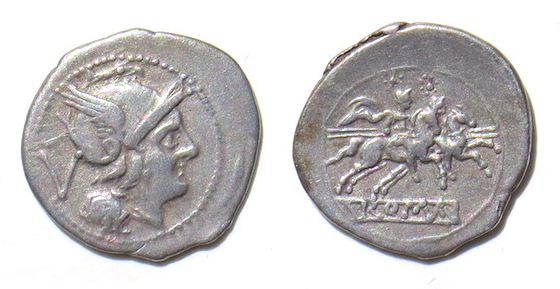
The quinarius denomination 
What's new? 2022, Dec. 12: Two fake quinarii.
2022, Dec. 1: Trajan quinarius.
2021, July 6: A comment on the term "quinarius."
2019, July 28: Quinarius of 90 BC by L. Calpurnius Piso Frugi
2018, Nov. 16: Hadrian quinarius.
The silver quinarius is a half-denarius piece. It was introduced during the Roman Republic in the same coin reform that introduced the denarius c. 212 BC during the Second Punic War against Carthage under Hannibal. The denarius was worth 10 asses and the quinarius 5. Each was clearly marked with a Roman numeral, X for 10 or V for 5. To the right is an early quinarius with "V" behind the head of Roma in a winged helmet right. The reverse has the Dioscuri (Castor and Pollux) riding right (distinguished by stars above their heads) and ROMA below.
The design of early quinarii was virtually the same as the design of early denarii. However, quinarii were smaller, 15-17 mm instead of 19 mm, and half the weight, about 2 grams instead of 4 grams. Here is an early denarius for size comparison (to the same scale--all image sizes are proportional to coin sizes):
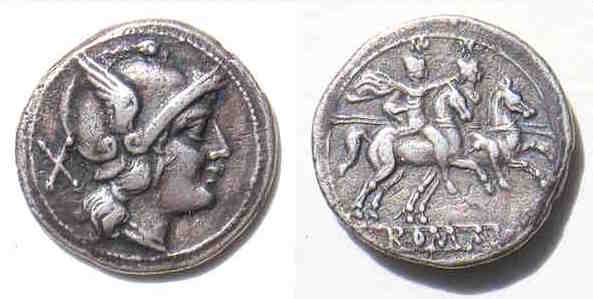
An early denarius. 19 mm.
Struck c. 211 BC.
Marked "X" for 10.
Helmeted head of Roma right/
the Dioscuri (Castor and Pollus) riding right (distinguished by stars above their heads)
ROMA below.
The denarius denomination became the main Roman silver denomination
and remained so for over 400 years.
Second Period (Republican of the Early First Century BC). The early Dioscuri type was discontinued c. 190 BC. After a gap of a ninety years with almost no production, the quinarius denomination was revived in 101 BC at the time of Marius. Ten moneyers issued types in the next twenty years, all of which are common. Here is the first type of the second period, issued in 101:
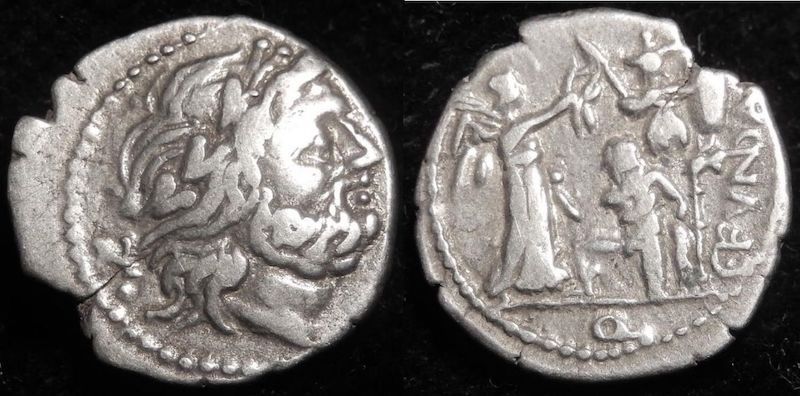
Issue of the moneyer C. Fundanius, 101 BC.
16-15 mm.
See his name up the right of the reverse: C.FVNDA
Laureate head of Jupiter right, behind, control mark
N with a dot below.
Victory right crowning a trophy with a kneeling naked captive,
Gallic carnyx behind
Q (for quinarius) below.
Crawford 326/1. Sear 205. King 31.
[For many other tyes of the Republican period, see below.]
The date of this revival was approximately known because of the "Lex Clodia" which ordered the production of quinarii. It is of uncertain date, but probably 104 or 103 BC. In 1973 Crawford proposed that the above quinarius type was the first of the revived denomination and it belonged to 101 BC. In 1910 BMC had put the issues of Egnatuleius and Cloulius (see below) earlier than this one because and it seemed natural for the "T CLOVLI" issue to be among the first. However, Crawford assigned that one (below) to later--97 BC. The date of 101 BC, two years later than the Lex Clodia might suggest, now seems to be accepted because this moneyer seems, from hoards, to be the first and, and the types of this quinarius and his denarius can be related to victories in Cisalpine Gaul (the Roman side of the Alps) and the subsequent triumph of Marius in 101 BC. The carnyx (a type of long and straight Gallic trumpet with the end like an animal's head) behind the captive makes certain the reference to a Gallic victory. (Of course, there were many other "Gallic" victories including some 20 years earlier.)
Third Period (Imperatorial, c. 48-27 BC). Next is the next famous "ASIA RECEPTA" issue of Octavian, which is the only common imperatorial type:

Bare head of Octavian right, CAESAR behind
ASIA RECEPTA, Victory standing left on cista mystica, flanked by two snakes
15-13 mm.
CAESAR IMP VII (the "IMP VII" on the right side is off the flan)
Struck 29-27 BC by Octavian, later to become Augustus, the first Roman emperor.
"Unequivocal in its proclamation of the extension of Octavian's authority to the province of Asia which, until his recent downfall, had been under Antony's rule ever since [the battle of] Philippi in 42 BC." (Sear HCRI, page 261)
Sear HCRI 429. Sear 1568. BMC 647. RIC 276. King, Augustus 1.
Fourth Period (Imperial). Almost all quinarius types from the imperial period are rare or very rare and seldom offered. Here is one of Domitian (AD 71-96):
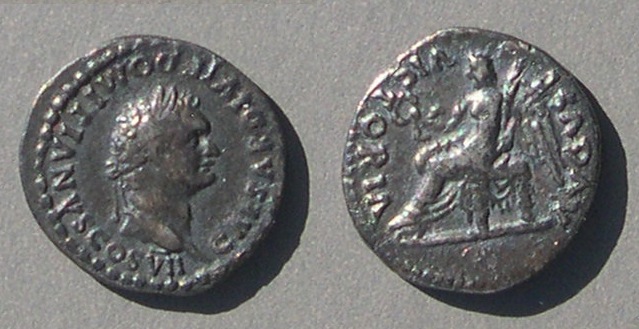
Domitian. 15 mm.
CAESAR DIVI F DOMITIANVS COS VII counterclockwise from 5:00
VICTORIA AVGVST counterclockwisse from 11:30
Victory seated left holding wreath and palm.
Sear 2646. RIC 53 (under Titus) "AD 80 and later". "DIVI" was after the deification of this father, Vespasian.
BMC (Titus) 104A. RIC 52. King, Domitian Caesar 10.
Observations and details
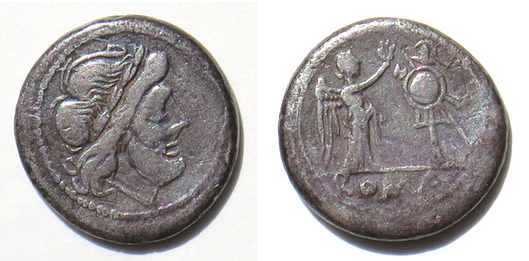
An early "Victoriatus", a denomination introduced c. 212 BC at the time the denarius was introduced, but on a different standard suitable for use in Gaul. It was lighter than the denarius and its silver was less pure. It may have served as the equivalent of an Italian Greek drachm.
Anonymous moneyer.
16 mm. Laureate head of Jupiter right
Victory crowning a trophy of captured arms, ROMA in exergue.
Crawford 44/1. Sear 49.
The minting of victoriati stopped c. 170 but they continued to circulate. Some argue the type of the reintroduced quinarius copied this type because the old victoriati in circulation may have declined in weight through wear to about half a denarius, so the half-denarius could use the same design.
Compare the type of this victoriatus to the next coin, a quinarius.
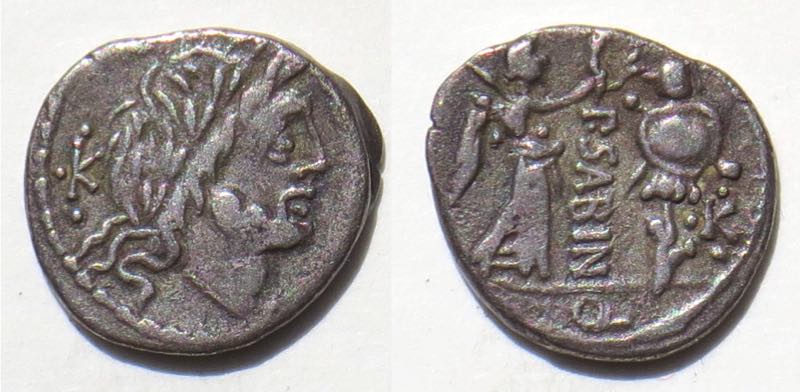
Quinarius. 14-13 mm.
Moneyer P. Sabinus. 99 BC
Laureate head of Jupiter right, control mark behind. This control mark is a K with dots above, below, and behind, the same on both sides.
Victory crowning a trophy of captured arms, P. SABIN downward between, control mark to right, Q in exergue.
Crawford 331/1. Sear 211. King 32.
You can see that the type was adopted from the old victoriatus.
[Other types from the second period are illustrated below.]
The Fifth period. "Quinarii" that may not be Quinarii.
By the mid-third century the denarius was no longer the main denomination. Denarii became rare and quinarii even more so. Under Gallienus (253-268) and later emperors there are some rare small laureate copper coins that are called "denarii" and some, even smaller, called "quinarii" that may be regarded as continuations of the quinarius denomination until the coin reform of Diocletian c. AD 294. They are listed in King's book. However, for collectors there are two later periods with coins often called "quinarii" which may not be quinarii, one under Allectus in Britain and the other under Diocletian and later emperors after the coin reform of c. 294 (They were struck primarily at Trier, but also at Rome and other mints.)
Under the British usurper Allectus (AD 293-296) there are laureate copper coins marked with a Q in exergue.
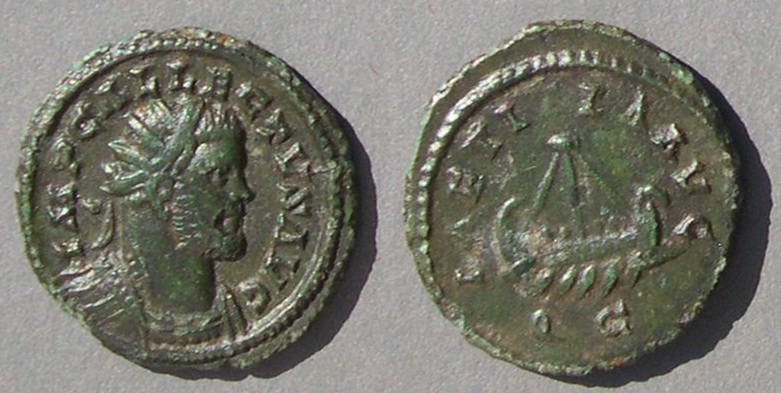
Allectus, AD 293-296
20 mm.
IMP ALLECTVS AVG
LAETITIA AVG, galley right
Q C in exergue
RIC V.II Allectus 126 "R", Camulodunum, the "C" mint.
Does the "Q" mean this is a quinarius? It is not a continuation of the silver denomination. The size is larger, the frequency greater, it is not laureate, and its time period not continuous with earlier issues. But, lacking ancient evidence for the name, the Q suggests "quinarius." Nevertheless, King omitted them from her book.
Under the tetrarchy there are numerous rare or very rare types much smaller than the usual "follis" (aka "nummus"). King lists pre-reform (that is, pre c. 293-4) types from numerous mints and does not list the post-reform types, many of which are "vota" types and most of which are from Trier. Zshucke categorizes most of the Trier types as 1/8 or 1/4 follis pieces. Later, under Constantine, when the follis itself was much reduced in size, he categorizes the largest of the small denominations as a 1/2 follis piece.
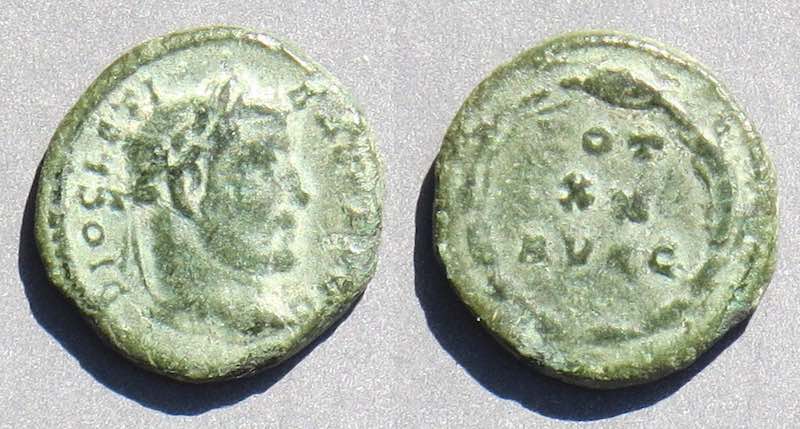
Diocletian, AD 284-305
Struck c. September 303 [both RIC and Zschucke]
14 mm. "1/8 follis"
DIOCLETI-ANVS AVG
VOT/XX/AVGG in wreath
RIC VI Trier 610a.
Zschucke 4.2
It is laureate and is smaller than the normal denomination. Therefore, this denomination (and also the denomination twice its size) is often called a quinarius, although that is an inappropriate name from a different series of denominations.
These small denominations regularly have "vows" and Zschucke associates them with anniversaries of reigns, struck for the days of the celebrations. (For more tetrarchal quinari, see below.)
Additional Examples. (Skip down to the reference works.)
Second Period: There are ten moneyers who minted quinarii in the period 101-81 BC, making ten easily distinguishable types. Here are some:
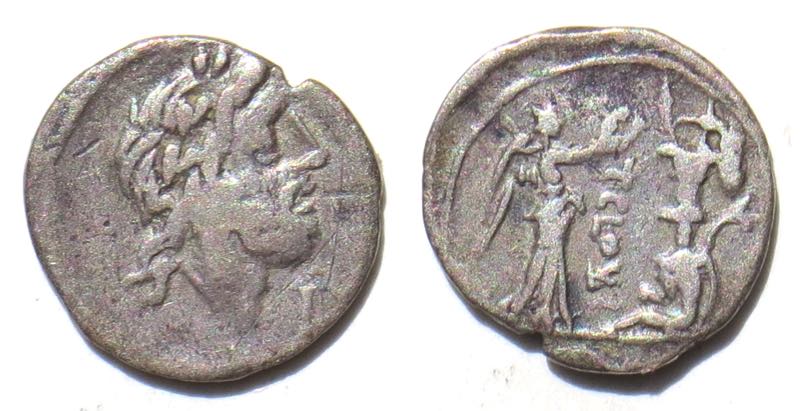
Moneyer T. Clovi, 98 BC.
16 mm.
Laureate head of Jupiter right
Victory crowning trophy, captive with carnyx
T CLOV downwards between
Crawford 332/1c. Sear 212. King 34.

Moneyer C. Egnatuleius C.f., 97 BC
15 mm.
C.EGNATVLEI C.F behind laureate head of Apollo right
Victory left adding shield to trophy on left, carnyx to left,
Q between, ROMA in exergue
Crawford 333/1. Sear 213. King 34.

Moneyer Q. Titius, 90 BC
13 mm, but thicker.
Bust of Victory right (with partial wing behind)
Pegasus right
Q.TITI below
Crawford 341/3. Sear 240. King 44.
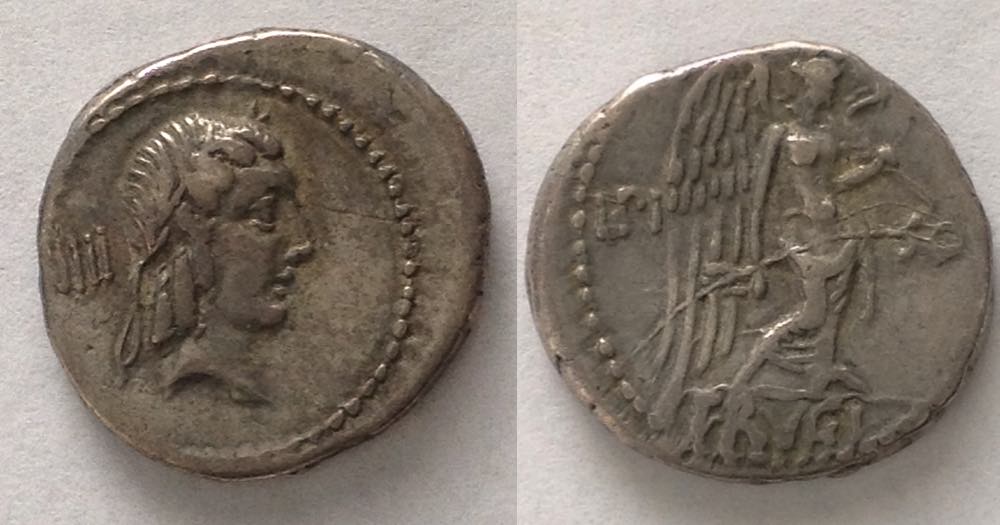 L. Calpurnius Piso Frugi, 90 BC
L. Calpurnius Piso Frugi, 90 BC
15 mm. 1.99 grams.
Apollo head right, IIII control mark behind
Victory standing right (with very large wings), holding palm branch over shoulder
L PI - SO either side
FRVGI in exerge
Crawford 340/2e [/2a to /2g have minor varieties in what Victory holds and where the letters are]
Sear I 236
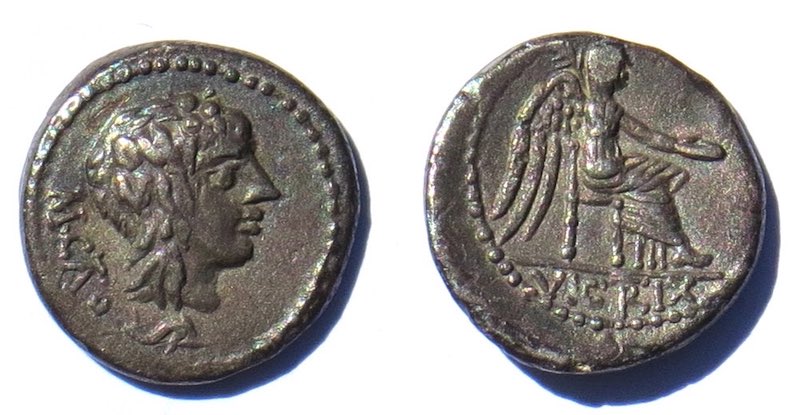
Moneyer M. Cato, 89 BC
14 mm.
M.CATO (AT ligate) head right, dolphin below
Victory seated right holidng out patera.
VICTRIX (TR ligate) in exergue
Crawford 343/2b. Sear 248. King 46.
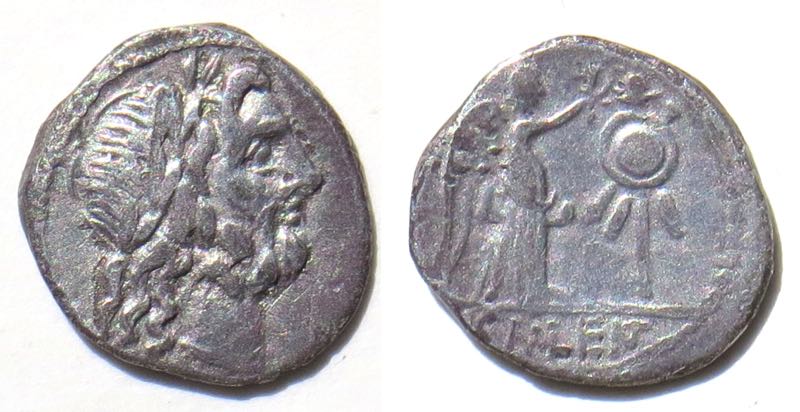
Moneyer Cn. Cornelius Lentulus, 88 BC
15-14 mm
Head of Jupiter right
Victory crowning trophy
CNLENT in exergue (NT ligate)
Crawford 345/2. Sear 255. King 47.

Moneyer L. Rubrius Dossenus, 87 BC
13 mm
Head of Neptune right with trident behind
DOS-SEN down left
Victory right [head clipped] with garlanded altar before
L.RVBRI down left
Crawford 348/4. Sear 261. King 48
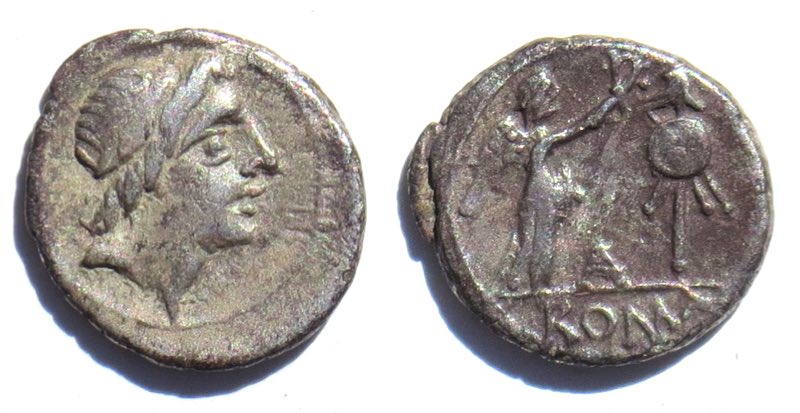
Anonymous moneyer, 81 BC
15-14 mm.
Apollo Head right, no legend
Victory crwoning trophy, A below
ROMA in exergue
Crawford 373/1b. Sear 305. King 50.
Minor differences (in legend location or control-mark location) bring the number of "types" listed by King up to twenty, some of which have control marks which would make many varieties of each.
 Mint moving with Octavian, 39 BC
Mint moving with Octavian, 39 BC
15 mm.
For Octavian and Mark Antony
III.VIR RPC Veiled head of Concordia right
Clasped hands holding caduseus
M ANTON C CAESAR [crudely done]
Crawford 529/4b. Sear 1575. King 81
Marking the reconciliation between Octavian and M. Antonius which took place at Brundisium late in 40.
Quinarii of the imperators from Julius Caesar through Octavian are rare and often of poor quality.
Roman imperial quinarii are small, but very often well-executed coins. Here is one of Galba:
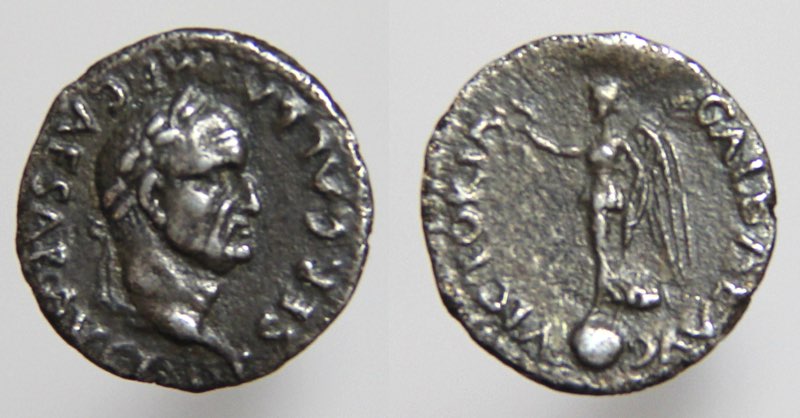
Galba, 9 June 68 - 15 Jan. 69
14 mm. 1.50 grams.
Obvere legend reads outward counterclowise from 5:00:
SER GALBA IMP CAESAR AVG PM TP
Victory standing on globe, holding out wreath, with palm over shoulder
VICTORIA GALBAE AVG
RIC Galba 131 (corrected to Victory left)
King, Galba 2
 Trajan, 98-117
Trajan, 98-117Here is one of Hadrian.
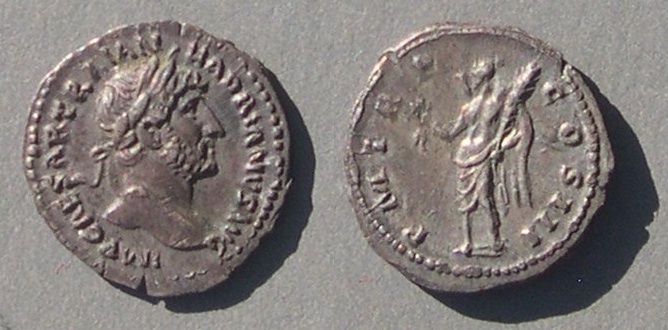
Hadrian. AD 117-138.
15 mm.
IMP CAESAR TRAIAN-HADRIANVS AVG
PM TRP COS III
Sear 3556. RIC 105. BMC 232 "AD 119-124 or 125".
King, Hadrian 39.
Hill 133 "AD 119"
Here is a second quinarius of Hadrian:
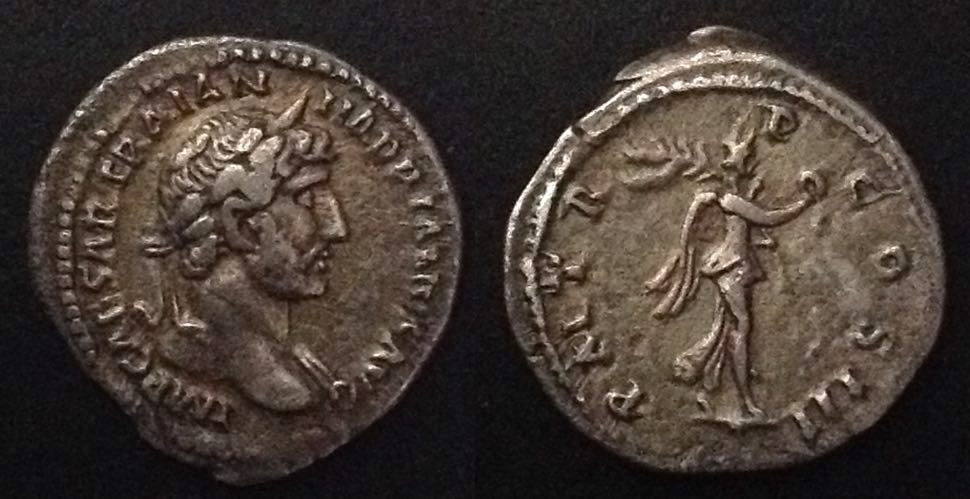
Hadrian, 117-138.
15 mm.
IMP CAESAR TRAIAN-HADRIANVS AVG
PM TRP COS III
Victory advancing right holding wreath and palm over shoulder.
RIC 103. BMC 222. "119-122". King 26.
Hill 132 "119"
Fifth Period--"Quinarii" that may not be.
Allectus issued two types of quinarii, both with a galley, but with different legends. One was shown above. Here is the other main type:
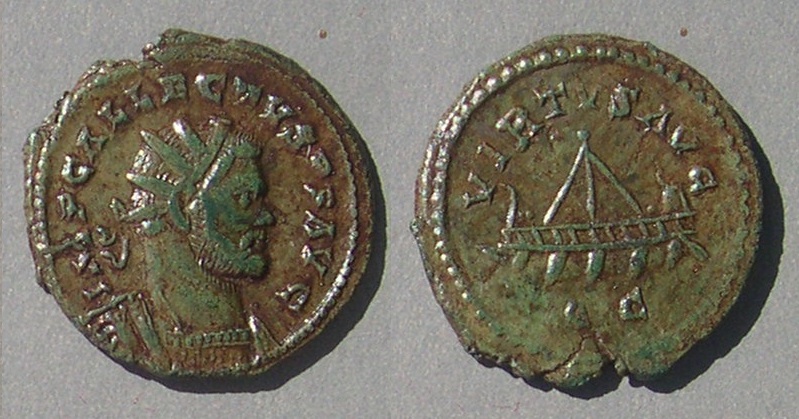
Allectus, 293-296
20 mm.
IMP C ALLECTVS AVG
VIRTVS AVG, galley left
Q C in exergue
RIC 128F, the "C" mint. "R"
Tetrarchal "quinarii" (in chronological order). (These come in three small sizes and may actually be fractions of a post-refom follis)
 [Repeated from above]
[Repeated from above]
Diocletian, AD 284-305
Struck c. September 303 [both RIC and Zschucke]
14 mm. "1/8" [The conjectured fraction of a follis]
DIOCLETI-ANVS AVG
VOT/XX/AVGG in wreath
RIC VI Trier 610a.
Zschucke 4.2
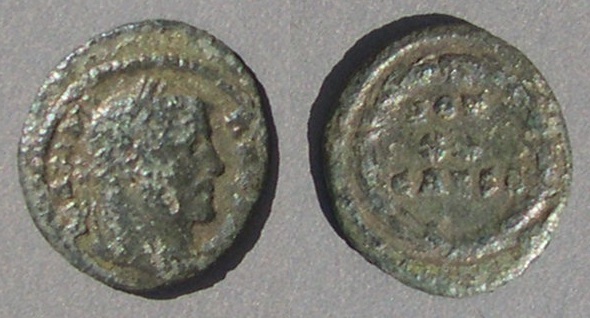
Galerius, 293-305-311
Struck as Caesar c. September 303
15-14 mm.
MAXIMI-ANVS NC
VOT/XX/CAESS i n wreath
RIC Trier 611 "r3"
Zschucke 4.7. "1/8"

Constantius, 393-305-306
Struck 305-306 [RIC]
14-13 mm
CONSTAN-TIVS AVG, laureate head right
VOT/XX/AVGG in wreath
RIC VI Trier 682a "R2"
Zschucke 5.5. "1/8"

Constantius, 293-305-306
Struck 305-306 [RIC]. Struck for May 1, 305 [Zschucke]
13 mm.
CONST-ANTIVS AVG, laureate draped bust right
VOT/XX/AVGG/NN in wreath
RIC VI Trier 684 "R3"
Zschucke 5.11. "1/8"
For size comparison, here is a similar "denarius" of the period, 17-18 mm instead of only 13 mm.
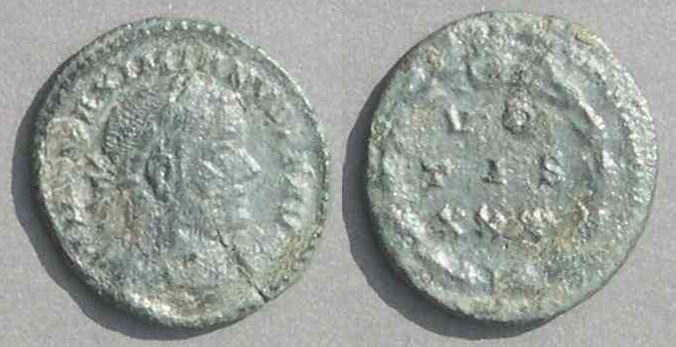
Maximian, 286-305 and again 306-308
Struck Summer 307 at Trier
18-17 mm.
IMP MAXIMIANVS PF AVG
VO/TIS/XXX in wreath
(Maximian had been forced to retire after twenty years. This coin of his second reign has vows for thirty years.)
RIC Trier 754 "R"
Zschucke 7.14b "1/4" and "D"
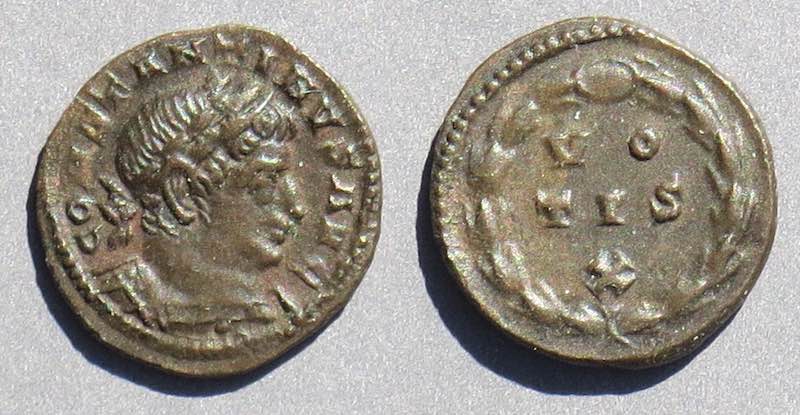
Constantine, 306-307-337
Struck 310-311 [RIC] Struck for July 25, 310 [Zschucke]
13 mm
CONSTANTINVS AVG, Laureat cuirassed bust right
VO/TIS/X in wreath
RIC VI Trier 906 "R"
Zschucke 11.4 (this coin). "1/4"

Constantine, 306-307-337
Struck for July 25, 310 [Zschucke]
13 mm
CONSTANTINVS AVG
VOT/X/MVL/XX
RIC VI Trier 913 "R2"
Zschucke 11.19-20 "1/4"
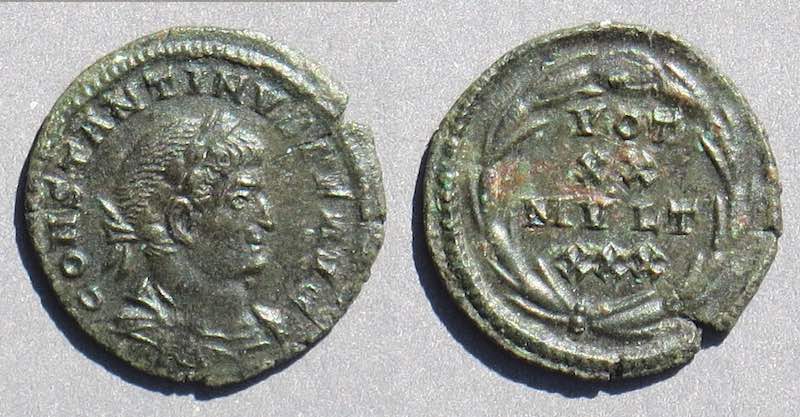
Constantine, 306-307-337
Struck c. July 25, 320 [Zschucke]
16 mm.
CONSTANTINVS AVG
VOT/XX/MVLT/XXX in wreath
RIC -- (Thesalonica 54 is close)
Zschucke 14.11a (This coin) "1/2"
Fakes. Here are two fake quinarii, obtained from eBay. I expect there are many more types of fake quinarii out there, but I have not made an attempt to discover them all.
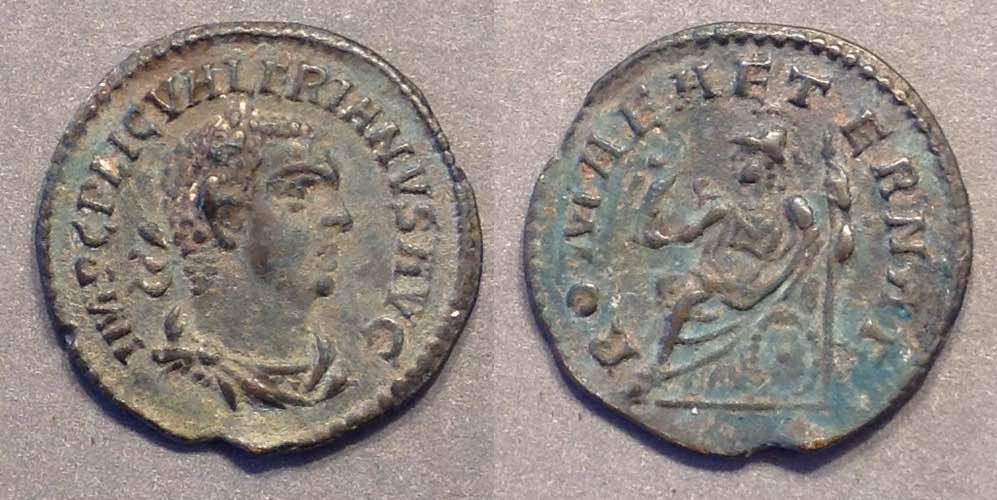 Valerian, 253-259. FAKE.
Valerian, 253-259. FAKE.
16.7 mm. 1.44 grams.
ROMAE AETERNAE
Excellent lettering. Very little wear. Nice surfaces. However, it is a fake and there are other identical copies offered. This one has a slightly different surface toning which makes it look old. It is not.
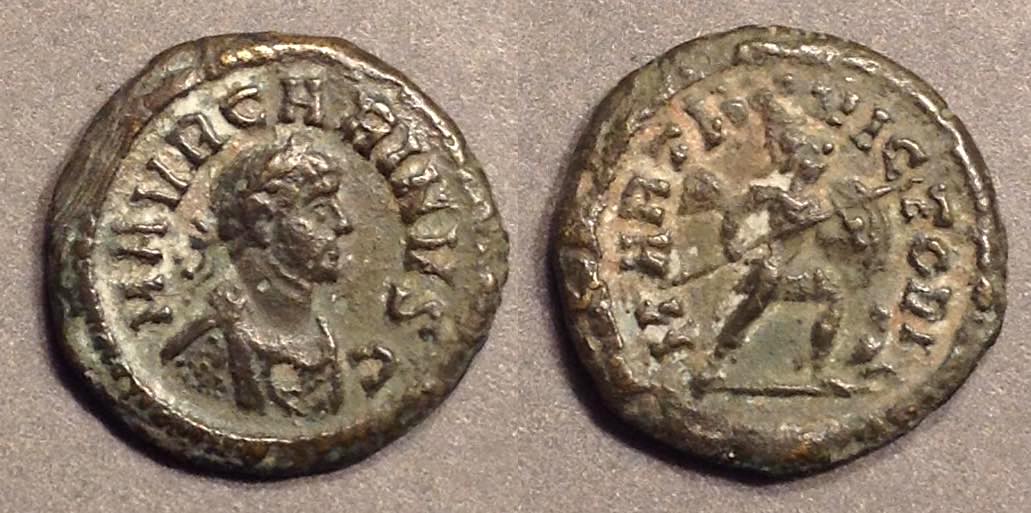 Carinus, 283-285. FAKE.
Carinus, 283-285. FAKE.Books:
King, Cathy. Roman Quinarii from the Republic to Diocletian and the Tetrarchy. 2007. Hardcover. 436 pages and 37 plates of life-sized photos plus 18 plates of enlargements.
This is the primary reference. It has a great deal of discussion and is by far the most complete list of types and nothing else comes close to its photographic coverage.
Crawford, Michael. Roman Republican Coinage, in two volumes, 1973
This is the primary reference for Roman Republican coins in general.
Grueber, H. A. Coins of the Roman Republic in the British Museum, volume 1. 1910. Pages 158-168 discuss the revival of the denomination (c. 101 BC) and the evidence. It is good to see these agreements because the evidence presented does not completely agree with Crawford's conclusions and Crawford does not explain his inferences at length.
Of course, RIC and BMC are references for imperial quinarii.
Articles:
Bracey, Robert. Review of "King, Cathy. Roman Quinarii from the Republic to Diocletian and the Tetrarchy" in NC 2008, pages 485-6.
Hersh, Charles. "A quinarius hoard from southern Italy" NC 1972 pages 75-88 and plates 8-11. [Includes 191 early Republican quinarii]
King, Cathy. "Denarii and quinarii, AD 253-295," pages 75-104 in Carson, R.A.G. and Colin Kraay. Scripta Nummaria Romana: Essays Presented to Humphrey Sutherland. 1978 HC [no photos, but a discussion of their role in the monetary system and weights]>
Sale Catalogs with some emphasis on quinarii:
Note: Major collections of Roman Republican coins usually have good selections of Republican quinarii included, and those catalogs are not listed separately here. Also, the tetrarchal AE fractions sometimes called "quinarii" are listed in their own subsection below.
Hess-Leu 41 1969, 24-25 April. 765 MV ancients on 35 ppl + 3 E. 732 R, 33 Byz.
Severan quinarii (9), Severan family types (at least two heads) (10), late Roman gold and silver (among 84), miliarensis (10)
NFA 10 1/2 Unnumbered after #10 (1/82) "Winter mail-bid sale" MV. MQP. 465 ancients. 299 G, 168 R including 6 RI quinarii, 8 Byz. 22 ppl + 4 ppl of antiquities.
NFA unnumbered #19 (12/87) "Winter mail-bid sale" MV. MQP. 1030 ancients. 522 G., 422 R including 9 RI quinarii, 79 Byz.
electrum (62)
NFA 20 (3/88) VHV. VHQP. 829 ancients. Thick catalog. Most with extensive commentary. 221 G, 608 R, including a gold quinarius of Trajan, 14 silver quinarii and 4 of the tetrarchy. Spectacular catalog.
rare late Roman emperors, 14 silver quinarii and 4 of the tetrarchy
NFA fixed price sheet number 1 dated Feb. 1986. A single sheet, entitled "Roman silver quinarii" with 16 Republican, 2 Marc Antony, and 7 imperial quinarii.
Sternberg 15 (4/85) MV. HQP. Hardcover. 864 ancients on 39 ppl + 4 E + 2 color ppl, among 54 ppl. 165 G, 24 aes garave on 4 ppl, 5 Italian social war, 110 RR including 15 early quinarii and many imperatorial, 524 RI (with 8 ppl of late Roman AE including 3 contorniates), 31 Byz
late Roman AE (on 8 ppl)
Sotheby's
1983, June 9. "Brand Collection 3" (Brown cardcover) HV. HQP. 468 ancients photographed throughout + 7 E + 2 color ppl. 191 G, 278 R.
gold quinarii of Augustus and Hadrian, and 13 silver quinarii
1984, Feb. 1. "Brand Collection 5" HV. MQP. 716 ancients, half illustrated on 24 ppl. 212 G, 504 R.
1 quinarius of Brutus and 12 silver RI quinarii
M&M fixed price list 349, Sept. 1973.
24 silver and 3rd C. quinarii among 45 ancients.
Leu 10 (5/74) VHV. HQP. 487 ancients on 27 ppl + 3 E. 461 R, 26 Byz.
17 RI quinaii and 1 Constantius half-argenteus
NFA unnumbered #19 (12/87) (vertical format) "Winter mail-bid sale" MV. MQP. 1030 ancients. 522 G., 422 R, including 9 RI quinarii, 79 Byz.
electrum (62)
NFA Unnumbered after #10 (1/82) (vertical format) "Winter mail-bid sale" MV. MQP. 465 ancients. 299 G, 168 R including 6 RI quinarii, 8 Byz. 22 ppl + 4 ppl of antiquities.
Kovacs mail bid sale XIV (10/98) 496 ancients. 99 G, 42 RP, 9 RR, 96 RI including 5 RI quinarii, 244 Byz AE.
An amazing group of Byz AE rarities: 7 Constantine IV, 4 Justininian II (1st reign), 18 Leontius, 6 Tiberius III, 5 Justinian II (second reign), 14 Philippicus, 11 Anastasius II, 4 Theodosius III, etc.
244 Byzantine AE
References to "Quinarii" of period 5 (that are often called "quinarii" but are not a continuation of the denomination).
Zschucke, Carl-Friedrich. Die Bronze-Teilstuck-Pragungen der Romischen Mumzstatte Trier. 1989. 65 pages including 16 page plates of coins.
[A complete list of all the fractional AE from Trier (263 types, not including those from Rome or other mints) issued under the tetrarchy and later. This is the (small) book you need for these issues. However, it does not cover those minted at Rome. You will need RIC for those.]
Failmezger, Victor. Roman Bronze Coins: From Paganism to Christianity, 294-364 AD. [A bare list of types with 6 photos, however, without significant discussion.]
Sale Catalogs for period 5:
M&M Basel (= Munzen und Medaillen, A.G. Basel = Monnaies et Medailles, S.S. Bale, Switzerland.
XIII (17-19 June 1954) VHV. MQP. 1051 ancients among 1225 on 36 ppl + 2 E among 48. A spectacular collection of coins of the tetrarchy, including very many rare copper fractional pieces and many silver argentei and many antoniniani. Also some late Roman gold, 99 outstanding PR, 260 G.
Tetrarchy (345), including late Roman fractions (78) and silver argentei (129 regular and 20 irregular)
61 (10/82) VHV and MV. MQP. 1466 lots of ancients on 72 ppl + 2 E. Divided into two parts. The first part of the catalog is a typical selection of VHV Greek and Roman coins. A second part is the Pierre Bastien Collection of late Roman AE. 239 G, 156 Roman Republican, 132 R, 9 spintriae, and then 926 lots of late Roman AE on 32 ppl. (Only tetrarchy and Constantinian family, not Valentinian and later.) All the late Roman AE are in outstanding condition and many lots consist of all the co-emperors of the same issue, although only one per type is usually illustrated. Over 40 of the rare fractional bronze are illustrated. This is the finest sale catalog of late Roman AE ever issued.
late Roman AE (926 lots) including 40 fractional AE (quinarii)
The End
Return to the main Table of Contents page.
This page first posted March 20, 2017